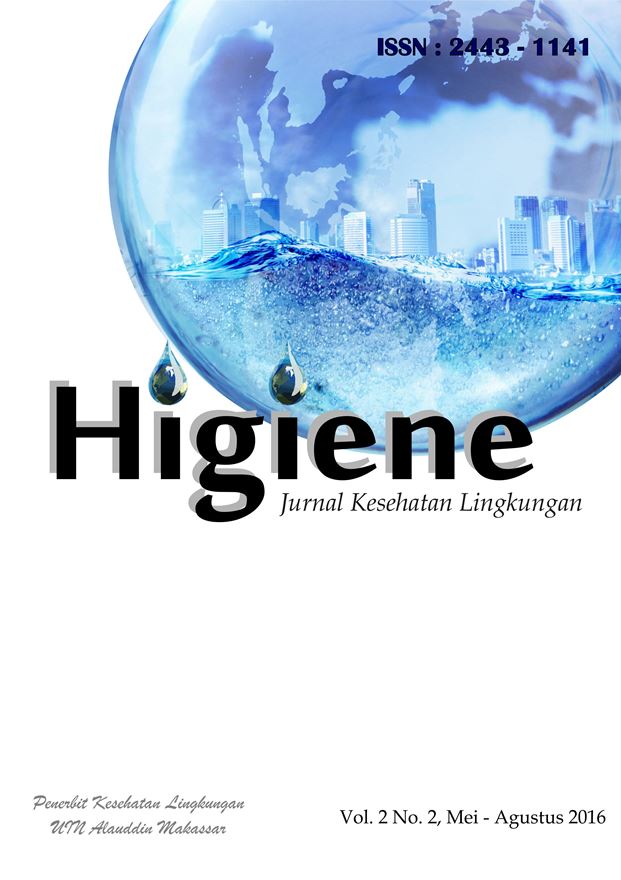Distribusi Spasial Kasus Kecacingan (Ascaris lumbricoides) Terhadap Personal Higiene Anak Balita di Pulau Kodingareng Kecamatan Ujung Tanah Kota Makassar Tahun 2016
Abstract
The worms infection is one of the disease that is very general, which is spread and contagious a lot of people in the world. Until now, this deaseas is still being a polemic because of the social condition and the economic condition in several place in the world. The worms phenomenon has the connectivity with the human’s characteristic, the environment, and the time. Kodingareng Lompo Island is the one of the island that placed in Makassar that become the highest victim area of the worms disease. So that, this research has the purpose to find out the spatial distribution of the wroms phenomenon in Kodingareng Lompo Island, Subdistrict Ujung Tanah Makassar City 2016. The sort of this research, is the quantitative research that using observational descriptive planning. The population in this research is all the worms disease case in 2016 and the sample is taken by using total sampling, with aggregate the 121 respondent.The researcher do the investigation for feces 121 respondent in laboratorium and find out the result that there are 73 respondents have the possitive get attacked by worms diseas and 48 with negative result of the worms diseas. The mapping by using Global Positioning System (GPS).The result of this research indicates that most of using sandals/shoes is 31,5%, nail sanitation protection category is 21,9%, the hand protection category is 9.6%, playing on the ground category is 76,7%, clothes sanition protection category is 15,1% , teeth sanition protection category is 21,3%,the most always showering behavior category is once a day is 74,0%. The worst of personal hygine and environmental sanitation that the lack of adequate become a problem that related to the worms illness in Kodingareng Lompo Island.Suggested the socialization to the people about the worms disease, through the print media or make the informal gathering and make an effort to increase the environment quality and personl hygine to avoid distributing the worms illness such as, toilet equipping, sewer water waste and the trash supplying.
Key word : Worms, Ascaris lumbricoides, spatial distribution
References
Altiara Silvia, 2010. Hubungan Sanitasi Lingkungan Rumah dengan Kejadian Cacingan Pada Balita di RW 03 Kelurahan Panggung Kota Tegal, 12.h.85
Arifin M Asriyani, 2013. Faktor-faktor yang berhubungan dengan Kejadian Cacingan Pada Siswa Sekolah Dasar Negeri Mafututu Kot Tidore Kepulauan, 05.h.89
Dani Sucipto Cecep, 2011. Aspek Kesehatan Masyarakat dalam AMDAL. Yogyakarta:Gosyen Publishing.
Fitri, 2012. Analisis Faktor-Faktor Risiko Infeksi Kecacingan Murid Sekolah Dasar di Kecamatan Angkola Timur Kabupaten Tapanuli Selatan, 06.h.7
Eryani Desti, 2014. Hubungan Personal Hygine dengan Kontaminasi Telur Soil Transmiited Helminthes Pada Kuku dan Tangan Siswa SDN 07 Mempawah Hilir Kabupaten Pontianak, 03.h.12
Gandahusaha Srisasi, 2000. Parasitologi Kedokteran, Jakarta:Gaya Baru.
Hairani Budi. Insidensi parasit pencernaan pada anak sekolah dasar di perkotaan dan pedesaan di Kabupaten Tanah Bumbu Kalimantan Selatan, vol. 4, No.2 (2012):h. 103
Handayani Dewi. 2005. Pemanfaatan Analisis Spasial untuk Pengolahan Data Spasial Sistem Informasi Geografi, Studi Kasus, vol.10, no. 2. h. 109
Jalaluddin, 2009. Pengaruh Sanitasi Lingkungan Personal Hygine dan Karakteristik Anak Terhadap Infkesi Kecacingan Pada Murid Sekolah Dasar di Kecamatan Blang Mangat Kota Lhokseumawe, vol. 02.h.85
Isro’in Laily, dkk, 2012. Personal Hygiene Konsep, Proses dan Aplikasi dalam Praktik Keperawatan, Yogyakarta:Graha Ilmu.
Lalandos Jansen Loudwik. 2008. “Prevalensi Infeksi Cacing Usus yang ditularkan Melalui Tanah Pada Siswa SD Gmim Lahai Roy Malalayang, vol. 03. No. 02. h.4.
Lengkong Brian R, Hubungan Sanitasi Higiene Perorangan dengan Infestasi Cacing Pada Pelajar Sekolah Dasar Negeri 47 Kota Mando, 04.h.14
Maryani Lidya, 2010. Epidemiologi Kesehatan.. Yogyakarta:Graha Ilmu.
Muchlisah Ainun, 2012. Hubungan Higine Perorangan dengan Kejadian Kecacingan di SD Athirah Bukit Baruga Makassar. 01.h.6
Natadisastra Djaenuddin, 2014. Parasitologi Kedokteran Ditinjau Dari Organ Tubuh yang Diserang. Jakarta:EGC.
Nur Muh. Ihramsyah, 2013. Faktor Risiko Sanitasi Lingkungan Rumah Terhadap Kejadian Kecacingan Pada Murid Sekolah Dasar di Pulau Barrang Lompo Makassar, 01.h.8
Prahasta Eddy. 2014. Sistem Informasi Geografis Konsep-Konsep Dasar (Perspektif Geodesi & Geomatika. Bandung:Informatika,
RI. Al-Qur’an dan terjemahnya (edisi yang disempurnakan), Banten:Kalim, 2011.
Sutrisna Bambang, 2010. Pengantar Metode Epidemiologi. Jakarta: Dian Rakyat.
Sunaryo, “Sistem Informasi Geografis Untuk Kajian Masalah Kesehatan, Balaba 6, no. 01 (2010):h. 26
Tom Elliot,dkk., 2013. Mikrobiologi Kedokteran & Infeksi. Jakarta:EGC.
Winita Rawina, dkk, “Upaya Pemberantasan Kecacingan Di Sekolah Dasar, Makara Kesehatan 16, no. 2 (2012):h. 66
Widoyono,2011. Penyakit Tropis, Epidemiologi, Penularan, Pencegahan & Pemberantasannya. Jakarta:Erlangga


